Techniques
Nerikomi
The Nerikomi technique is an ancient Chinese technique, in which the white porcelain is coloured with colour pigments and oxides. The pigments and oxides are weighed and added to the porcelain and mixed together. This is how Marjan makes a colour palette.
By mixing and stacking the coloured porcelain in different ways and then cutting it again, patterns (Sushi) are created. Now all is formed into a block-shaped piece of porcelain. Very thin slices are cut . The pattern that is created (Agaath stone) is rolled out into a thin plate. This plate is cut into a desired shape and then mounted together. This creates a fragmentary form.
She also uses Nerikomi to produce the literal translation of an existing painting by, for example, Vermeer or van Gogh, which is quite a challenge! Both the inside and the outside of the form receive the same amount of attention; the image can be seen on both sides. This gives the object a special appearance, quite different from a painted image.
Agate
Marjan uses the Agate technique when turning the porcelain objects. First of all, different colours of porcelain are piled up for this. A colour spiral is created by the rotating movement of the potterswheel. The pressure exerted by her hand to raise the clay mass causes an imprint of her fingers. She turns with different colours to emphasize the rotation: it seems as if she is conjuring up the colours.
Porcelain in general and the Nerikomi and Agate technology in particular deform the object during the drying and firing process. (20%). However, Marjan has a lot of experience with working with porcelain and using these techniques. The unpredictability of this process makes it a challenge to realize her ideas.
INSPIRATION
Sources of inspiration
The ceramic work of Marjan is based on intuitive visual impulses and at the same time strongly connected to the classic ceramic container form; it is therefore open to multiple interpretations. “I colour the white porcelain in a picturesque way with colour pigments. By applying special glazes over the pigments, the dynamics in colour and composition is created. Porcelain is the ideal material to realize my ideas: characteristically refined, flowing and glassy. The distortion during firing is a process that I can not predict exactly in advance, but that is what makes it so attractive and surprising”.
Japan
In 2001 there was an exhibition in the Rijksmuseum in Amsterdam “Hotei Poetry and image in Japanese prints”. These Japanese Surimono inspires her.
The subjects of the Surimono can be introverted and expressive. They often have the theme of the Japanese landscape and people with their simple lives. This is shown in an illusionary way with atmospheric colours.
The Surimono is also used as a playbill for the Kabuki theater, on which the actors are depicted in their traditional costumes. She uses the graphic aspect and the paper effect in her porcelain objects. “In these images of beautiful costumes I see motifs that I convert to the Nerikomi technique”.
China
In addition to Japan, Marjan is also inspired by the Chinese Opera Theater (Beijing) from the 18th and 19th centuries. This mainly concerns the movement of the performers, their costumes and the colors.
Marjan has also been to China several times and has visited the traditional opera herself. “I try to use the colour and shape to simulate the original and give it my own interpratation”.
Old Masters
Another source of inspiration is paintings of european old masters for example Johannes Vermeer, Maria Sybilla Merian, Vincent van Gogh and Fouquet: for example the interesting use of colour and the special styling of Johannes Vermeer and the fragility of the flower and insect drawings by Maria Sybilla Merian.
“Vincent van Gogh appeals to me because of his exuberant colors and his flamboyant style. I take the painting as a starting point and the attentive spectator will certainly recognize elements of the work in it. Using the paintings as a reference I try to use colours and shapes to come as near to the essence of the original”.
Nature
Another source of inspiration is nature, with its apparent chaos and abundance of organisms. Colourful works are vitreous and capricious and I create my own natural shapes: very thin with hard stakes; slender like the skeletons of different creatures. Using paper thin edges dots, alternating surfaces of opaque and translucent body-stained porcelain I create new organic structures.

Kabuki Visitors | Nerikomi

Wabi Sabi | Agate

